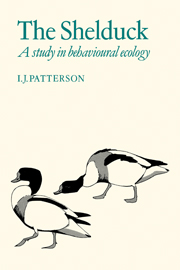Book contents
- Frontmatter
- Contents
- Acknowledgments
- 1 Introduction
- 2 The shelduck
- 3 Gregariousness: the winter flock
- 4 Territories
- 5 Prospecting for nest sites
- 6 Laying and incubation
- 7 Care of the young
- 8 Duckling survival
- 9 Recruitment and the non-territorial flock
- 10 The limitation of shelduck populations
- References
- Subject index
- Author index
9 - Recruitment and the non-territorial flock
Published online by Cambridge University Press: 04 August 2010
- Frontmatter
- Contents
- Acknowledgments
- 1 Introduction
- 2 The shelduck
- 3 Gregariousness: the winter flock
- 4 Territories
- 5 Prospecting for nest sites
- 6 Laying and incubation
- 7 Care of the young
- 8 Duckling survival
- 9 Recruitment and the non-territorial flock
- 10 The limitation of shelduck populations
- References
- Subject index
- Author index
Summary
On reaching adulthood the young animal faces the problem of settling into the patch of habitat which may be its home for the rest of its life. The selection of an area is crucial to the individual's genetic fitness since it may affect both survival and breeding success and thus the total number of progeny produced in the animal's lifetime. Many individuals settle preferentially in their natal area, but others emigrate and face a choice between different regions for settlement. Selection of an area may depend mainly on assessment of the resources available but should also take into account the degree of competition for them. The response of individuals to increasing competition may limit the total number of young which settle in a local population and this may be important in the limitation of density.
In many territorial species, recruitment occurs in two stages, firstly to the non-territorial flock and then from there to the attainment of a breeding territory, sometimes several years later (Charles, 1972). In this chapter I will describe the return of young adult shelducks to the flock, the factors affecting settlement and the possible consequences for population density.
Return of the young
After dispersing for their first winter, many young shelducks return to their natal area, mostly when about one year old. Of 60 Ythan-reared ducklings (ringed before fledging) which returned, 45 per cent were first seen as yearlings, 40 per cent as two-year-olds and 15 per cent at three years old (Patterson et al., in press b).
- Type
- Chapter
- Information
- The ShelduckA Study in Behavioural Ecology, pp. 218 - 236Publisher: Cambridge University PressPrint publication year: 1982



